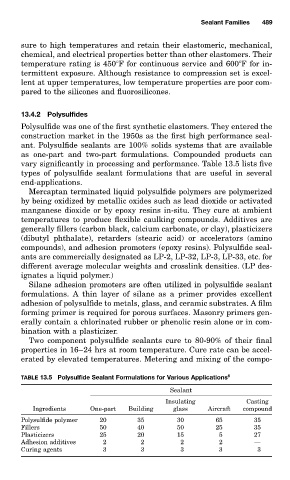Page 568 - Handbook of Adhesives and Sealants
P. 568
Sealant Families 489
sure to high temperatures and retain their elastomeric, mechanical,
chemical, and electrical properties better than other elastomers. Their
temperature rating is 450 F for continuous service and 600 F for in-
termittent exposure. Although resistance to compression set is excel-
lent at upper temperatures, low temperature properties are poor com-
pared to the silicones and fluorosilicones.
13.4.2 Polysulfides
Polysulfide was one of the first synthetic elastomers. They entered the
construction market in the 1950s as the first high performance seal-
ant. Polysulfide sealants are 100% solids systems that are available
as one-part and two-part formulations. Compounded products can
vary significantly in processing and performance. Table 13.5 lists five
types of polysulfide sealant formulations that are useful in several
end-applications.
Mercaptan terminated liquid polysulfide polymers are polymerized
by being oxidized by metallic oxides such as lead dioxide or activated
manganese dioxide or by epoxy resins in-situ. They cure at ambient
temperatures to produce flexible caulking compounds. Additives are
generally fillers (carbon black, calcium carbonate, or clay), plasticizers
(dibutyl phthalate), retarders (stearic acid) or accelerators (amino
compounds), and adhesion promoters (epoxy resins). Polysulfide seal-
ants are commercially designated as LP-2, LP-32, LP-3, LP-33, etc. for
different average molecular weights and crosslink densities. (LP des-
ignates a liquid polymer.)
Silane adhesion promoters are often utilized in polysulfide sealant
formulations. A thin layer of silane as a primer provides excellent
adhesion of polysulfide to metals, glass, and ceramic substrates. A film
forming primer is required for porous surfaces. Masonry primers gen-
erally contain a chlorinated rubber or phenolic resin alone or in com-
bination with a plasticizer.
Two component polysulfide sealants cure to 80-90% of their final
properties in 16–24 hrs at room temperature. Cure rate can be accel-
erated by elevated temperatures. Metering and mixing of the compo-
TABLE 13.5 Polysulfide Sealant Formulations for Various Applications 8
Sealant
Insulating Casting
Ingredients One-part Building glass Aircraft compound
Polysulfide polymer 20 35 30 65 35
Fillers 50 40 50 25 35
Plasticizers 25 20 15 5 27
Adhesion additives 2 2 2 2 —
Curing agents 3 3 3 3 3

